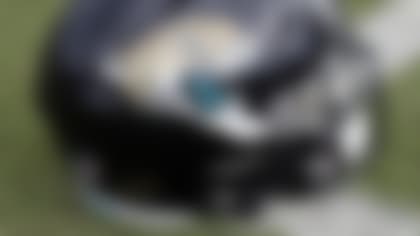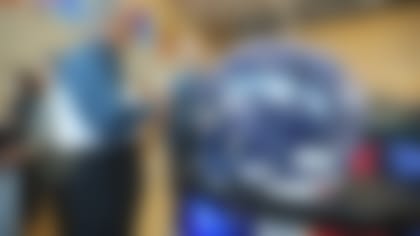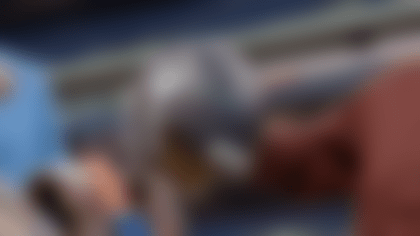The NFL Helmet Challenge
Q. What is the NFL Helmet Challenge?
A. The NFL Helmet Challenge is an innovation challenge that aims to stimulate the development by experts, innovators and helmet manufacturers of a new helmet for NFL players that outperforms, based on laboratory testing, all helmets currently worn by NFL players. Helmet prototypes will be submitted for testing in laboratory conditions that represent potentially concussive impacts in the NFL. The challenge will culminate in July 2021 with applicants' submissions of helmet prototypes, which will be evaluated by scientific and medical experts to compete for up to a $1 million award. This challenge is the next phase in the NFL's Engineering Roadmap, which aims to improve the understanding of football biomechanics and to create incentives for small businesses, entrepreneurs, innovators and helmet manufacturers to develop new protective equipment.
Q. What criteria will be used to assess my helmet design?
A. Helmets must meet certain design constraints based upon laboratory test performance and comparability to the physical attributes of helmets currently used by NFL players. Helmet prototypes must achieve a Helmet Performance Score (HPS) of 0.70 or lower to be eligible to win the NFL Helmet Challenge. HPS is calculated using the test conditions and scoring methods described in the helmet test protocol. The full set of requirements for the design (the "Design Constraints") are listed below.
The Design Constraints are based on the laboratory test performance and physical attributes of helmets currently used by NFL players. The test conditions used to evaluate laboratory performance of submissions have been specified based upon the type and severity of impacts NFL players experience during NFL games, which may not be applicable to other levels of play outside the NFL.
Helmet prototypes submitted for NFL Helmet Challenge testing must meet the following Design Constraints:
1. Submissions must be a complete helmet system suitable for use in the NFL and able to complete testing under the helmet test protocol.
- While plastic deformation of the faceguard, and superficial damage (such as scuffing) to the helmet shell/guard are expected during testing under the helmet test protocol, the submission must remain intact and ready for use or continued testing (e.g., it must not sustain cracks to the shell or fracturing or permanent set of any energy-absorbing component during testing). Helmets must be submitted along with seven faceguards with eye and oral protection, seven chinstraps and associated attachment hardware. Helmet-mounted hardware must remain as provided (for example, parts on the straps may be replaced during testing, but not parts on the helmet).
2. Submissions must be capable of satisfying the testing, durability, and other requirements set forth by NOCSAE standards ND001, ND002, ND081, and ND087.
3. Novel designs (for example, "diving bell" type designs that structurally engage the head with the torso and thereby create the potential for greater effective mass when striking another player) must be shown to not create new safety risk for participants or limit range of motion.
4. Submissions must allow range of motion and range of vision comparable to helmets currently in use in the NFL.
5. Mass, dimensions, and standoff of submissions must be comparable to helmets currently used by NFL players:
- Total helmet mass, including faceguard and retention system (i.e. chin strap or equivalent) shall not exceed 2.2 kg.
- Helmet width measured without the faceguard when the helmet is positioned on the Hybrid III headform shall not exceed 255 mm, and maximum width with the faceguard shall not exceed 268 mm.
- Helmet length projected onto the Hybrid III x-y plane shall not exceed 308 mm from the most anterior point of the helmet to the most horizontal posterior point on the helmet when donned on the Hybrid III headform.
- Faceguard standoff shall not exceed 70 mm.
- Top standoff must be less than or equal to 82 mm.
- When donned on the Hybrid III 50th percentile male headform, the helmet must generate less than 77 kPa of pressure against the dummy skin at any location of contact as measured according to the methods in the helmet test protocol.
A panel of expert judges including helmet experts, biomechanical engineers, medical experts and materials experts will determine whether a helmet submitted for NFL Helmet Challenge testing meets these Design Constraints in order to be eligible for testing under the helmet test protocol identified above. Any submission is subject to disqualification if the expert panel determines that the design introduces or has the potential to introduce a new risk or consequence that is not addressed by the helmet test protocol and to which the application has not provided adequate supporting information. All participants in the challenge must agree to and comply with the NFL Helmet Challenge Rules and Regulations.
Q. How will the Challenge winners be determined?
A. Helmet prototypes that meet the Design Constraints must achieve a Helmet Performance Score (HPS) of 0.70 or lower to be eligible to win the NFL Helmet Challenge.
In the case of multiple submissions meeting the Design Constraints above, the panel of expert judges will score submissions based on an evaluation of a set of Assessment Criteria, including:
- The HPS score.
- Is the submission feasible for use in the NFL?
- Does the submission have high potential for acceptance by NFL players (design, appearance, perceived comfort, inertia, hearing, venting, donning/doffing, etc.)?
- Does the submission have the ability to perform in the NFL environment? For example, would it tolerate storage (at a low range of 10° F with upper range of 120° F), repeated cleaning, exposure to sunlight, prolonged heating, sweat and potentially corrosive environments?
- Does the submission have the ability to attain certification under the NOCSAE standards?
Q. What will happen if no submitted helmet prototype achieves a Helmet Performance Score (HPS) of 0.70 or lower?
A. There would be no winner of the NFL Helmet Challenge. However, the NFL is always interested in supporting the development of innovations that may improve the health and safety of the game or its players and may, in its discretion and in consultation with the Judging Panel, determine to award supplemental awards to the most intriguing submission(s). Such award(s) may consist of a discretionary bonus, coaching or mentorship or other benefits. Supplemental awards may also be considered even in the event that there is a winner of the NFL Helmet Challenge.
Q. What is the award for winning the NFL Helmet Challenge?
A. Submissions that satisfy all of the Design Constraints will be eligible to win a prize of up to one million dollars ($1,000,000). In the event that multiple submissions satisfy all of the Design Constraints, up to three submissions may be awarded a portion of the one million dollar ($1,000,000) prize. One Grand Prize winner will receive at least five hundred thousand dollars ($500,000). Submissions will be ranked according to their total score, and the prize will be apportioned based on those scores and the Assessment Criteria; however, the Judging Panel reserve the right to award fewer than the anticipated number of cash awards (including zero awards), in the event an insufficient number of eligible Applications meet the Judging Criteria for the challenge, in the Judging Panel's sole discretion.
Q. Who will do the testing of the physical prototype?
A. Physical prototypes will be tested by Biocore LLC and evaluated by an expert panel, including a number of engineers, scientists, researchers and other experts. Helmet prototypes submitted to Biocore for testing may be damaged during testing and will not be returned to applicants.
Q. How many helmets does an Applicant need to submit?
A. It is asked that Applicants submit one helmet prototype. A full list of submission requirements can be found in the Official Rules.
Q. How do I determine whether my helmet prototype met the submission deadline?
A. In order to meet the submission deadline, the helmet prototype and other required materials (see Submission Requirements) must be postmarked (or, for a verified delivery service (e.g., Federal Express), the courier has confirmed receipt of the package) by the July 14, 2021 submission deadline. The NFL is not responsible for lost, late, misdirected, damaged, stolen, altered, incomplete or delayed submissions.
Q. What is HPS?
A. HPS is based on the kinematics of the Hybrid III head in a series of 18 impacts using a linear impactor striking the helmeted head at 3 speeds at each of 6 locations on the helmet. An intermediate set of metrics (viz. HIC, DAMAGE, and HARM) are required for the calculation of HPS, as detailed in the helmet test protocol.
Q. How were the impact conditions determined?
A. The impact conditions used in the calculation of the HPS are based on analysis and reconstructions of certain on-field impacts previously associated with concussions in the NFL. The impact conditions are specific to the NFL and may not apply to other levels of play.
Q. Are finite element models of modern helmets available?
A. Biocore and Football Research Inc. (FRI), with funding support provided by the NFL, have collaborated with partners at the University of Virginia, Wake Forest, KTH Royal Institute of Technology and the University of Waterloo to develop open-source finite element (FE) models of four modern football helmets and associated impact test methods and equipment, including the Hybrid III headform and neck. These models are available subject to the licensing terms. Technical specifications and experimental validation data for the models were developed by Biocore and provided to these university partners, who created the computational models using physical helmets. The models are available here.
Q. Where can I download the Hybrid III headform finite element model?
HeadHealthTECH Challenges (HHTC) Grant Program
Q. What is the purpose of the HeadHealthTECH Grant Program?
A. The National Football League (NFL) and Football Research, Inc. (FRI) have partnered with Duke University's Clinical and Translational Science Institute (Duke CTSI) to create the HeadHealthTECH Challenges, a series of innovation challenges intended to deepen understanding of and advance solutions in the areas of head protection, materials science and kinematic measurement, among others. The TECH Challenges are structured to stimulate research and innovation, as well as encourage connections with mentors and/or venture capitalists, with a goal of spurring developments in engineering, biomechanics, advanced sensors and material science.
The NFL is making up to $2 million in HeadHealthTECH grant funding available to NFL Helmet Challenge applicants to support the creation of a physical helmet prototype for laboratory testing. Applications are being accepted from November 18, 2019 – March 31, 2020. Grants will be awarded in May 2020.
Q. How will my team be evaluated for grant funding?
A. A Panel of Judges will perform a detailed review of the applications and select the teams to be awarded grant funding. The following criteria will be considered when reviewing and scoring applications:
- The strength of the team submitting an Application, particularly with regard to such team's potential ability to optimize helmet design and to deliver a physical helmet prototype that could win the Helmet Challenge;
- The potential efficacy of the proposed helmet design concept and whether the proposed helmet design concept has the potential to meet the Design Constraints described in Paragraph 11 of the Helmet Challenge Official Rules; and
- The explanation of the budget and the components thereof, the perception that the team submitting an Application will be able to operate within such budget, and the ability to bring in-kind resources to the project.
Q. What are the funding levels available for HeadHealthTECH Helmet Challenge grants?
A. Multiple awards with a cumulative value of up to $2 million will be available through the HeadHealthTECH Helmet Challenge grant program. Applications must describe the complete team and a fully conceived plan for developing a winning physical helmet, including design and manufacturing. Companies, universities and individuals may receive grant funding, but all grantees must comprise or be part of a team having the expertise necessary to create an improved helmet. Applicants must justify all components of their budget and describe any in-kind resources they will provide. Teams that provide in-kind resources will be given preference in the evaluation process. Applications for HHTC grant funding must be submitted by March 31, 2020. Awards will be made in May 2020.
Q. Is the grant funding tied to a deliverable?
A. Yes. If you are selected for grant funding, 50% of the Award will be paid upfront, followed by the remaining 50% paid upon completion of a prototype that meets the Design Constraints described in the Helmet Challenge Official Rules.
Q. Is computational modeling required?
A. No, but it is anticipated that successful teams will need to employ advanced design optimization techniques to attain an HPS of 0.70 using the helmet test protocol.
Q. Do I have to participate in the grant program in order to submit a helmet to the Challenge?
A. No.
General FAQs
Q. What is a team?
A. Teams should include members having the expertise to design and develop a physical prototype helmet that attains an HPS of 0.70 using the helmet test protocol. It is anticipated that teams will therefore include expertise in computational mechanics, biomechanics, helmet design and design optimization, prototyping, materials and manufacturing.
Q. Can participants be part of more than one team?
A. Yes, the purpose of this challenge is to stimulate research and innovation using state-of-the-art engineering design, prototyping and testing methods. Experts in these areas may engage with one or multiple teams.
Q. Are there any other requirements I should be aware of?
A. Yes. The complete set of the NFL Helmet Challenge Official Rules and Regulations is available here.
Q. Who can I contact if I have questions that are not answered here?
A. Please address questions to helmetchallenge@nfl.com
*These FAQs may be updated from time to time in response to questions received.










